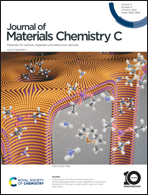High performance and self-powered photodetectors based on Se/CsPbBr3 heterojunctions†
Abstract
The inorganic perovskite CsPbBr3 has attracted much attention in photodetector fabrication. In this paper, Se/CsPbBr3 heterojunctions were prepared by a spin coating method by combining highly crystallized p-type Se microtubes (Se-MTs) and n-type CsPbBr3 nanoparticles. Se-MTs were deposited by chemical vapor deposition at a relatively low temperature of 330 °C. CsPbBr3 nanoparticles can enhance light absorption in the wavelength range of 350–550 nm, improving the optical response of p–n Se/CsPbBr3 junctions. The Se/CsPbBr3 heterojunction photodetectors exhibit excellent self-powered characteristics and a broadband spectral response range of 368–800 nm. Especially, under an illumination of 550 nm under zero bias voltage, Se/CsPbBr3 detectors exhibit maximum responsivity (47.6 mA W−1, 436% higher than that of pure Se-MT at 0.1 V), the highest specific detectivity of 4.9 × 1010 Jones (two times higher than Se-MT at 0.1 V), a high on/off ratio of 235, and fast response speed (18/40 ms). Therefore, the low-cost and high responsivity make this device quite promising in broadband high-performance devices with self-powered detection.

- This article is part of the themed collection: #MyFirstJMCC


 Please wait while we load your content...
Please wait while we load your content...